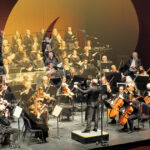Program Notes, ©2013 Lori Newman
Program Notes
Felix Mendelssohn Violin Concerto in e minor, op. 64 (1844)
(Born 1809, Hamburg, Germany; died 1847, Leipzig, Germany)
There is perhaps no more popular or beloved violin concerto than Felix Mendelssohn’s masterpiece in e minor. The prodigy’s concerto breaks the Romantic violin concerto tradition of vapid showpieces with little need for artistry or passion, and whose orchestra parts are sparse, insipid, and uninteresting. Mendelssohn referred to these Paganini inspired works as merely “juggler’s tricks and rope dancer’s feats.” Mendelssohn’s Violin Concerto was the first significant concerto for violin since Beethoven’s of 1806, and was the last until the concertos of Bruch in 1868, and Tchaikovsky and Brahms, both written in 1878.
In 1838, Mendelssohn wrote to the violinist Ferdinand David and stated, “I would like to compose a violin concerto for you next winter; one in e minor sticks in my head, the beginning of which will not leave me in peace.” Mendelssohn had been appointed the music director of the Leipzig Gewandhaus Orchestra in 1835, and immediately named his childhood friend, Ferdinand David, the orchestra’s concertmaster. The concerto would be Mendelssohn’s last orchestral endeavor, and took him six years to complete from the time he initially wrote to David. David was involved in every aspect of the concerto’s composition and served as its technical advisor – a testament to how much Mendelssohn respected David, seeing that Mendelssohn was a capable violinist himself. The work premiered on March 13, 1845, with the Leipzig Gewandhaus Orchestra, David as soloist, and Neils Gade conducting.
The Mendelssohn Violin Concerto is groundbreaking and goes against established concerto conventions in several ways, beginning overtly in the opening of the first movement. Instead of a lengthy orchestral introduction which would lay out the principal themes of the concerto, Mendelssohn writes a measure and a half introduction, that really only serves to outline the key of e minor, and immediately brings in the soloist with the principal thematic material. This changes the formal structure of the first movement by alleviating the need for a double exposition (one for the orchestra, and one for the soloist). Mendelssohn again breaks with tradition in the placement of the concerto’s cadenza – putting it before the recapitulation instead of after it. It is believed that Ferdinand David was possibly responsible for the cadenza’s material, which notably, Mendelssohn wrote into the score. It would have been standard procedure of the time to leave it up to the performer to improvise a cadenza. Mendelssohn again goes against standard concerto format by not breaking between the movements of his concerto, instead, creating a single movement work with three distinct movements.
As with all popular and ubiquitous works, there can be critical backlash that questions the artistic or musical value of an oft-played piece. Mendelssohn’s Violin Concerto has escaped this fate because it is undeniably a masterpiece in the violin repertoire. In 1921, the esteemed musicologist, Sir Donald Francis Tovey, wrote, “I rather envy the enjoyment of anyone who should hear the Mendelssohn (violin) concerto for the first time and find that, like Hamlet, it was full of quotations.”




